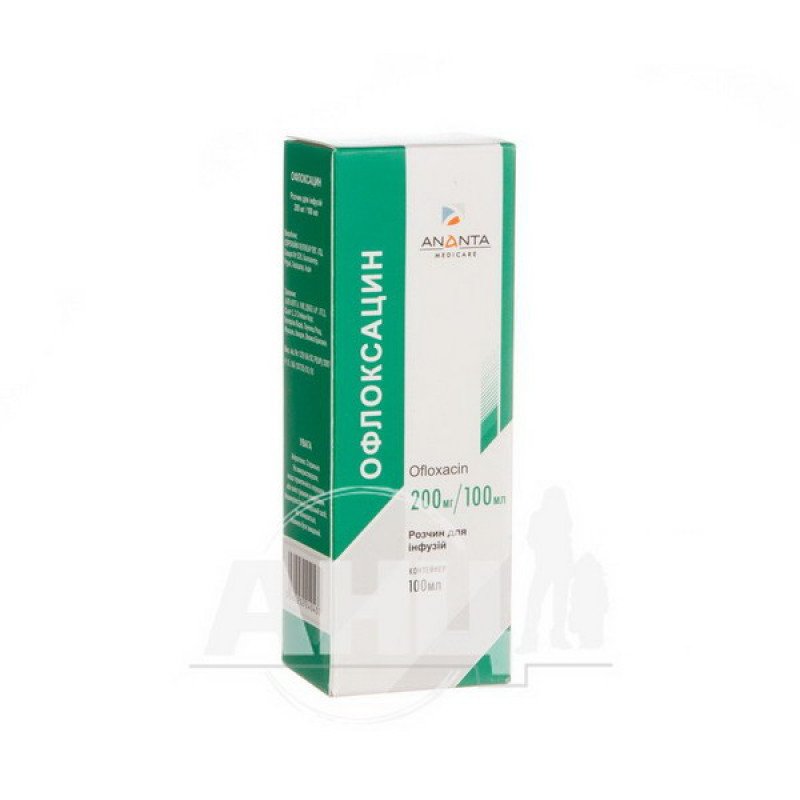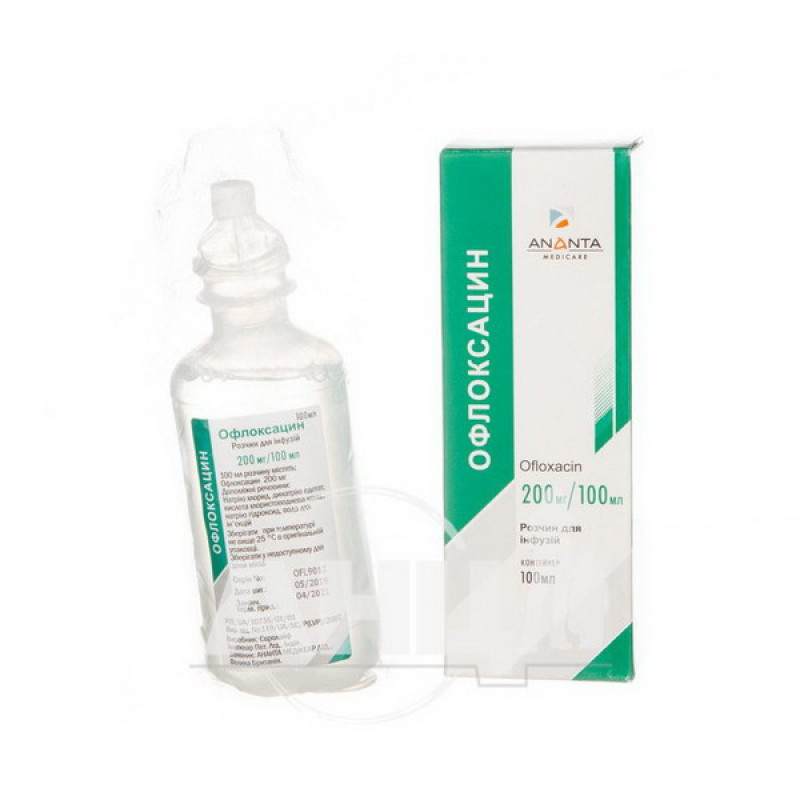Ofloxacin solution for injection 200 mg/100 ml container 100 ml No. 1

Ofloxacin infusion solution is used for infectious and inflammatory diseases caused by pathogens sensitive to ofloxacin:
exacerbation of chronic obstructive pulmonary disease (including chronic bronchitis), community-acquired pneumonia; uncomplicated acute cystitis, urethritis, acute pyelonephritis and complicated urinary tract infections; complicated skin and soft tissue infections.Composition
The active substance is ofloxacin (100 ml of solution contains 200 mg of ofloxacin).
Excipients: sodium chloride, disodium edetate, concentrated hydrochloric acid, sodium hydroxide, water for injections.
Contraindication
hypersensitivity to ofloxacin and other components of the drug or other drugs of the fluoroquinolone group; epilepsy; central nervous system damage with a reduced seizure threshold (after craniocerebral trauma, stroke, inflammatory processes of the brain and meninges); history of tendinitis; glucose-6-phosphate dehydrogenase deficiency; ofloxacin should not be prescribed to patients with prolonged QT interval, patients with uncompensated hypokalemia, as well as patients taking class IA (quinidine, procainamide) or class III (amiodarone, sotalol) antiarrhythmic drugs.Method of application
For use in adults. Administer intravenously by drip. Before administration, a skin allergy test should be performed.
The dose of Ofloxacin is set by the doctor individually depending on the sensitivity of microorganisms, the type and severity of the infectious process.
Exacerbation of chronic obstructive pulmonary disease (including chronic bronchitis), community-acquired pneumonia: 200 mg twice daily.
Uncomplicated acute cystitis, urethritis, acute pyelonephritis and complicated urinary tract infections: 200 mg twice daily.
Complicated skin and soft tissue infections: 400 mg twice daily.
The infusion time should be at least 30 minutes for each 200 mg. In general, individual doses should be administered at equal intervals. A dose of 400 mg twice daily may be used in severe or complicated infections.
The duration of use of ofloxacin depends on the type of infectious process and clinical indicators. After normalization of body temperature and improvement of the patient's general condition, treatment should be continued for another 3 days.
In most cases of acute process, the duration of treatment is 7-10 days. The doctor can transfer the patient from parenteral administration to oral administration without changing the dose.
The duration of treatment should not exceed 2 months.
Application features
Pregnant women
Ofloxacin is contraindicated during pregnancy. It is recommended to discontinue breastfeeding during treatment with ofloxacin.
Children
The drug is contraindicated in children.
Drivers
The speed of psychomotor reactions may be impaired, so you should refrain from driving vehicles and mechanisms. Since in isolated cases drowsiness, impaired ability to drive mechanisms, dizziness and visual disturbances have been reported after taking the drug, patients should be aware of their body's reaction to ofloxacin before driving vehicles or working with complex mechanisms.
Overdose
The most important expected signs of acute overdose are CNS symptoms, including dizziness, disorientation, drowsiness, confusion, lethargy, convulsions, as well as gastrointestinal reactions such as nausea, vomiting, and erosive lesions of the mucous membranes.
There is no antidote. Symptomatic treatment with the drug "Ofloxacin" is mainly excreted by the kidneys (75-80% of the administered dose is excreted unchanged in the urine within 24-48 hours), its elimination can be accelerated by forced volumetric diuresis. Only a limited amount of ofloxacin can be removed from the body by hemodialysis (on average 15-25%) or peritoneal dialysis (less than 2%).
ECG monitoring is necessary due to possible QT interval prolongation.
Side effects
Infectious and parasitic diseases: mycosis, resistance of pathogenic organisms.
From the blood and lymphatic system: lymphocytosis, thrombocytosis, prolongation of prothrombin time, hemolytic anemia, leukopenia, eosinophilia, thrombocytopenia, anemia, agranulocytosis, pancytopenia, suppression of bone marrow hematopoiesis.
On the part of the immune system: anaphylactic reactions, anaphylactoid reactions, hypersensitivity reactions (usually with skin manifestations), anaphylactic shock, anaphylactoid shock, facial edema, angioedema, edema of the tongue and/or larynx with possible asphyxia.
Metabolic and nutritional disorders: anorexia, increased blood glucose levels, increased serum cholesterol levels, increased serum triglyceride levels, hypoglycemia in diabetic patients taking glucose-lowering drugs.
Vascular disorders: Short-term hypotension, vasculitis, phlebitis, tachycardia and hypotension may occur during ofloxacin infusion. In very rare cases, this decrease in blood pressure may be severe.
From the gastrointestinal tract: stomach discomfort, abdominal pain, nausea, vomiting, enterocolitis, sometimes hemorrhagic; constipation, decreased appetite, loss of appetite, diarrhea, dysbiosis, pseudomembranous colitis.
Hepatobiliary disorders: increased liver enzymes (AST, ALT, LDH, GGT and/or alkaline phosphatase), increased blood bilirubin, cholestatic jaundice, hepatitis, which can sometimes be severe.
Skin and subcutaneous tissue disorders: pruritus, rash, urticaria, flushing, increased sweating, pustular eruptions, vasculitis, erythema multiforme, toxic epidermal necrolysis, photosensitivity, drug dermatitis, vascular purpura, vasculitis, which in exceptional cases can lead to skin necrosis; Stevens-Johnson syndrome, acute generalized exanthematous pustulosis, drug eruption.
On the part of the kidneys and urinary tract: urinary retention, increased urea and serum creatinine levels; impaired renal function, in some cases - acute renal failure, acute interstitial nephritis.
Congenital and familial/genetic disorders: attacks of porphyria in patients with porphyria.
Interaction
Ofloxacin solution cannot be mixed with heparin and other infusion solutions, except those whose compatibility with ofloxacin has been studied.
When administered with drugs that alkalize urine (carbonic anhydrase inhibitors, citrates, sodium bicarbonate), the risk of crystalluria and nephrotoxic effects increases.
Storage conditions
Store in the original packaging at a temperature not exceeding 25 °C, out of the reach of children.
Shelf life - 3 years.
There are no reviews for this product.
There are no reviews for this product, be the first to leave your review.
No questions about this product, be the first and ask your question.







